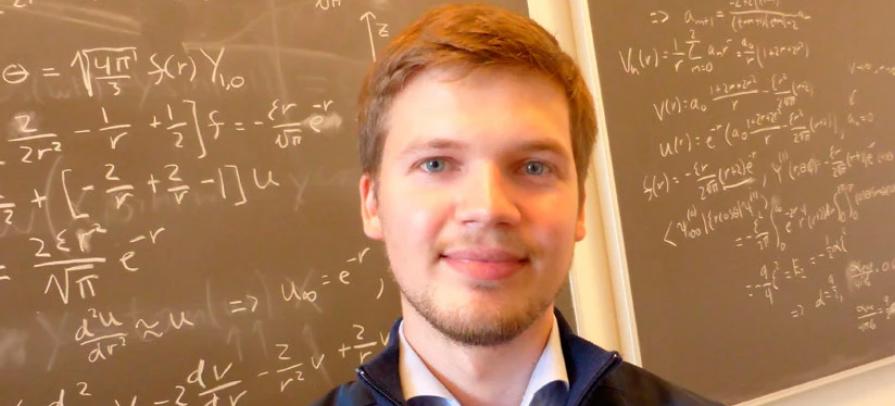Høgni Carlsson Kamban vart ph.d. við Aalborg Universitet
Týsdagin 31. mai 2022 vardi Høgni Carlsson Kamban ph.d.-ritgerð sína um eksitonir í sera tunnum tilfari við Institut for Materialer og Produktion, Aalborg Universitet.
Ritgerðin er skrivað við støði í kvantimekanikki, sum er partur av alisfrøðini, ið fæst við eginleikar í tilfari á atomarum og subatomarum støði. Í stuttum er ein eksiton sett saman av einari elektron og einum positivt ladaðum partikli, ið verður nevndur eitt hol. Tá eksitonin kemur undir eitt elektriskt felt, verða elektronin og holið togaði burtur frá hvørjum øðrum. Um feltið er nóg sterkt, verða tey skild sundur og kunnu tískil vera við til at fáa ein elektriskan streym at renna gjøgnum tilfarið. Hetta verður eitt nú nýtt í sólsellum. Ritgerðin kannar, um eksitonir í onkrum av tí tynsta tilfarinum, ið finst, kunnu skiljast sundur við elektriskum feltum, og endamálið er at rokna, hvussu skjótt hetta fer fram, alt eftir hvørjum strukturi eksitonin er stødd í.
Verjan gekk sera væl. Høgni Carlsson Kamban fekk nógv rós fyri bæði framløguna, ritgerðina og svarini til spurningarnar frá metingarfólkunum.
Høvuðsvegleiðari hevur verið Thomas Garm Pedersen, professari á Institut for Materialer og Produktion, Aalborg Universitet.
Í metingarnevndini vóru:
Kjeld Pedersen, professari á Aalborg Universiteti, sum leiddi verjuna
Kirill Bolotin, professari á Freie Universität Berlin
Nikolaj T. Zinner, professari á Aarhus Universitet
Heiti á ritgerðini: Field-induced Dissociation of Excitons in Mono- and Bilayer Structures.
Abstract
The focus of this thesis is to study electric-field-induced dissociation of excitons in material structures based on both monolayer materials and bilayer heterostructures. Excitons are quasi-particles found in semiconductors and insulators. When an electron is excited from the valence band, typically by absorbing a photon, it leaves behind a vacancy in this band. This vacancy behaves like a positively charged particle and is referred to as a hole.
The excited electron and hole are attracted to one another via the Coulomb force due to their opposite electric charge. They may therefore form a bound state, and it is this bound state that is known as an exciton. Excitons in bulk semiconductors are usually weakly bound, and thermal agitation is sufficient to dissociate them into free electrons and holes. This is not the case for mono- and bilayer structures, however. As the number of layers composing the material structure reduces, the screening of the interaction between electrons and holes also reduces. This leads to a stronger interaction between electron-hole pairs, and exciton binding energies therefore become larger. Such strongly bound excitons are thermally stable, and it is therefore interesting to see if one may assist the dissociation process by applying in-plane electric fields to the excitons.
A recent experiment showed that the photoresponse rate of a WSe2 monolayer increases as a static electric field is applied to the excitons. The field-induced increase in photoresponse rate at weak fields was well described by a Wannier exciton dissociation model. However, it proved difficult to obtain theoretical predictions of exciton dissociation rates when the electric fields were sufficiently weak. One of the goals of the present thesis was to find a numerical method capable of efficiently computing these weak field dissociation rates. This method has subsequently been used to compute exciton dissociation rates in monolayer transition metal dichalcogenides (TMDs), phosphorene, and bilayer TMD heterostructures. The results indicate an exponential dependence on field strength, particularly in weak electric fields. The exciton binding energy is, furthermore, found to be the dominating parameter determining exciton dissociation rates, but reduced masses and substrate screening also have an impact. This is made clear by deriving an analytical weak field approximation in which all of these parameters are included.
Dissociation induced by THz pulses is also considered for excitons in monolayer TMDs. The results are obtained using a fully time-dependent Wannier model and indicate that realistic THz pulses are able to dissociate a substantial amount of excitons in realistic semiconductors.
Samband: Høgni Carlsson Kamban
